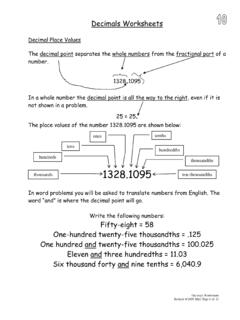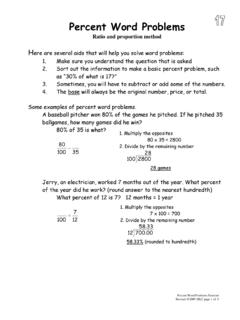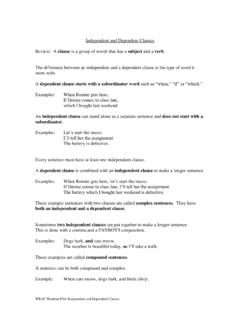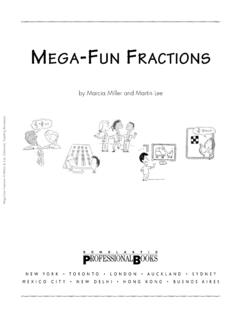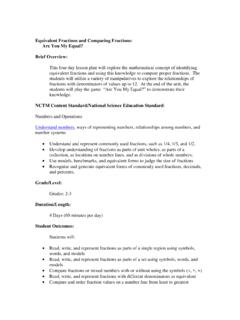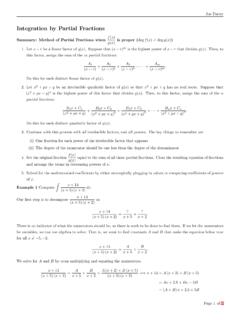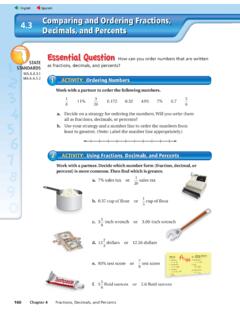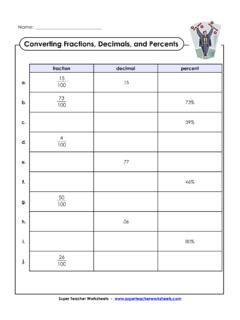Transcription of Fractions Packet - CNM
1 Fractions Packet Created by MLC @ 2009 page 1 of 42 Fractions Packet Contents Intro to page 2 Reducing page 13 Ordering page 16 Multiplication and Division of page 18 Addition and Subtraction of page 26 Answer page 39 Note to the Student: This Packet is a supplement to your textbook Fractions Packet Created by MLC @ 2009 page 2 of 42 Intro to Fractions Reading Fractions Fractions are parts. We use them to write and work with amounts that are less than a whole number (one) but more than zero. The form of a fraction is one number over another, separated by a fraction (divide) line. 95and,43,21 These are Fractions . Each of the two numbers tells certain information about the fraction (partial number). The bottom number (denominator) tells how many parts the whole (one) was divided into.
2 The top number (numerator) tells how many of the parts to count. 21 says, Count one of two equal ports. 43 says, Count three of four equal parts. 95 says, Count five of nine equal parts. Fractions can be used to stand for information about wholes and their parts: EX. A class of 20 students had 6 people absent one day. 6 absentees are part of a whole class of 20 people. 206 represents the fraction of people absent. EX. A Goodbar candy breaks up into 16 small sections. If someone ate 5 of those sections, that person ate 165 of the Goodbar . Fractions Packet Created by MLC @ 2009 page 3 of 42 Exercise 1 Write Fractions that tell the following information: (answers on page 39) 1. Count two of five equal parts 2. Count one of four equal parts 3.
3 Count eleven of twelve equal parts 4. Count three of five equal parts 5. Count twenty of fifty equal parts 6. It s 25 miles to Gramma s. We have already driven 11 miles. What fraction of the way have we driven? 7. A pizza was cut into twelve slices. Seven were eaten. What fraction of the pizza was eaten? 8. There are 24 students in a class. 8 have passed the Fractions test. What fraction of the students have passed Fractions ? The Fraction Form of One Because Fractions show how many parts the whole has been divided into and how many of the parts to count, the form also hints at the number of parts needed to make up the whole thing. If the bottom number (denominator) is five, we need 5 parts to make a whole: 155. If the denominator is 18, we need 18 parts to make a whole of 18 parts: 11818.
4 Any fraction whose top and bottom numbers are the same is equal to 1. Example: 166,111111,1001001,44,122 Fractions Packet Created by MLC @ 2009 page 4 of 42 Complementary Fractions Fractions tell us how many parts are in a whole and how many parts to count. The form also tells us how many parts have not been counted (the complement). The complement completes the whole and gives opposite information that can be very useful. 43 says, Count 3 of 4 equal parts. That means 1 of the 4 was not counted and is somehow different from the original 3. 43 implies another 41 (its complement). Together, 44make41and43, the whole thing. 85 says, Count 5 of 8 equal parts. That means 3 of the 8 parts have not been counted, which implies another 83, the complement.
5 Together, 85 and 83 make 88 , which is equal to one. Complementary Situations It s 8 miles to town, We have driven 5 miles. That s 85 of the way, but we still have 3 miles to go to get there or 83 of the way. 85 + 83 = 88 = 1 (1 is all the way to town). A pizza was cut into 12 pieces. 7 were eaten 127. That means there are 5 slices left or 125 of the pizza. 127 + 125 = 1212 = 1 (the whole pizza). Mary had 10 dollars. She spent 5 dollars on gas, 1 dollar on parking, and 3 dollars on lunch. In fraction form, how much money does she have left? Gas = 105 , parking = 101 , lunch = 103 105 + 101 + 103 = 109 ; 101 is the complement (the leftover money) Altogether it totals 1010 or all of the money. Fractions Packet Created by MLC @ 2009 page 5 of 42 Exercise 2 (answers on page 39) Write the complements to answer the following questions: 1.
6 A cake had 16 slices. 5 were eaten. What fraction of the cake was left? 2. There are 20 people in our class. 11 are women. What part of the class are men? 3. It is 25 miles to grandma s house. We have driven 11 miles already. What fraction of the way do we have left to go? 4. There are 36 cookies in the jar. 10 are Oreos. What fraction of the cookies are not Oreos? Reducing Fractions If I had 20 dollars and spent 10 dollars on a CD, it s easy to see I ve spent half of my money. It must be that 212010. Whenever the number of the part (top) and the number of the whole (bottom) have the same relationship between them that a pair of smaller numbers have, you should always give the smaller pair answer. 2 is half of 4. 5 is half of 10. 21 is the reduced form of 105 and 42 and 2010 and many other Fractions .
7 A fraction should be reduced any time both the top and bottom number can be divided by the same smaller number. This way you can be sure the fraction is as simple as it can be. 105 both 5 and 10 can be divided by 5 2151055105 21 describes the same number relationship that 105 did, but with smaller numbers. 21 is the reduced form of 105. 86 both 6 and 8 can be divided by 2. 43282686 Fractions Packet Created by MLC @ 2009 page 6 of 42 43 is the reduced form of 86 . When you divide both the top and bottom numbers of a fraction by the same number, you are dividing by a form of one so the value of the fraction doesn t change, only the size of the numbers used to express it. 862162121612 These numbers are smaller but they can go lower because both 6 and 8 can be divided by 2 again.
8 43282686 43312391292242182418 739639276327or73321392193633276327 Exercise 3 (answers on page 39) Try these. Keep dividing until you can t divide anymore. 1. 86 = 2. 1512 = 3. 1814 = 4. 108 = 5. 126 = 6. 2416 = Good knowledge of times tables will help you see the dividers you need to reduce Fractions . Here are some hints you can use that will help, too. Hint 1 If the top and bottom numbers are both even, use 22. Hint 2 If the sum of the digits is divisible by 3 then use 33. 231111 looks impossible but note that 111 (1+1+1) adds up to three and 231 (2+3+1) adds up to 6. Both 3 and 6 divide by 3 and so will both these numbers: 773732313111231111 The new fraction doesn t look too simple, but it is smaller than when we first started. Fractions Packet Created by MLC @ 2009 page 7 of 42 Hint 3 If the 2 numbers of the fraction end in 0 and/or 5, you can divide by 55.
9 1495705457045 Hint 4 If both numbers end in zeros, you can cancel the zeros in pairs, one from the top and one from the bottom. This is the same as dividing them by 1010 for each cancelled pair. 25225024504500004000500004000 Hint 5 If you have tried to cut the fraction by 22, 33, 55 and gotten nowhere, you should try to see if the top number divides into the bottom one evenly. For 6923, none of the other hints help here, but 69 23 = 3. This means you can reduce by 2323. 31236923236923 For more help on reducing Fractions , see page 13 Exercise 4 (answers on page 39) Directions: Reduce these Fractions to lowest terms 1. 1814 2. 10080 3. 3618 4. 5000400 5. 2520 6. 3627 7. 4540 8. 8163 9. 129 10. 8560 11. 5117 12. 7550 Fractions Packet Created by MLC @ 2009 page 8 of 42 Higher Equivalents There are good reasons for knowing how to build Fractions up to a larger form.
10 It is exactly the opposite of what we do in reducing. If reducing is done by division, it makes sense that building up should be done by multiplication. 42222121 159353353 5448696898 A fraction can be built up to an equivalent form by multiplying by any form of one, any number over itself. 1812636232 128434232 332211323211 1510535232 963322128181232 All are forms of 32; all will reduce to 32 comparing Fractions Sometimes it is necessary to compare the size of Fractions to see which is larger or smaller, or if the two are equal. Sometimes several Fractions must be placed in order of size. Unless Fractions have the same bottom number (denominator) and thus parts of the same size, you can t know for certain which is larger or if they are equal.
